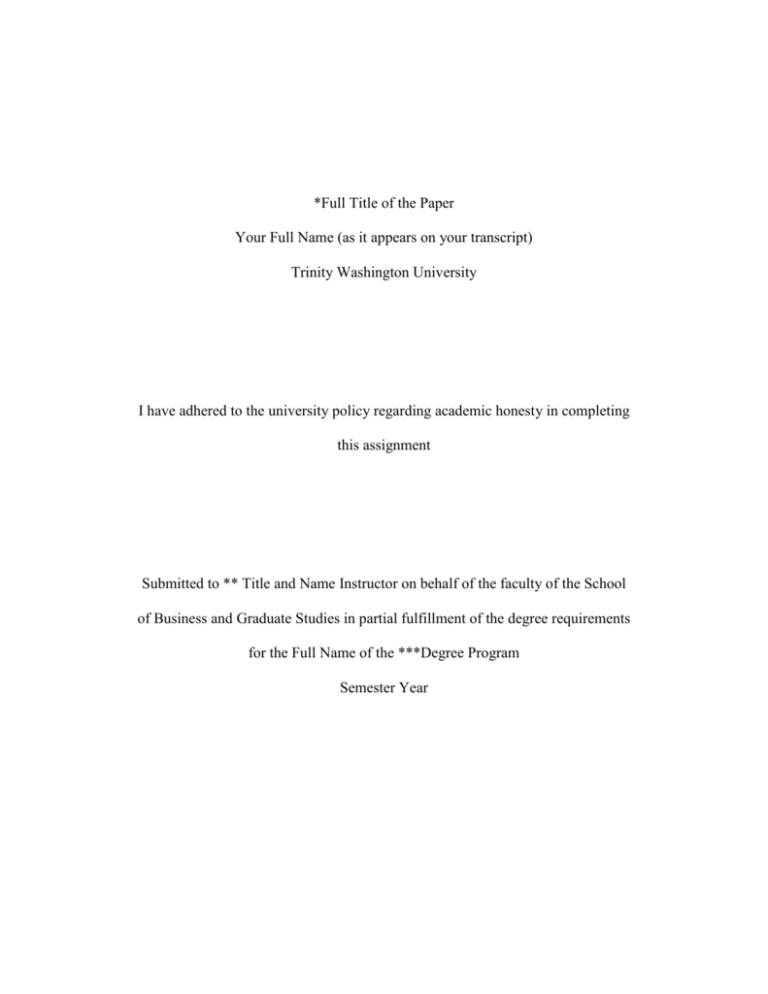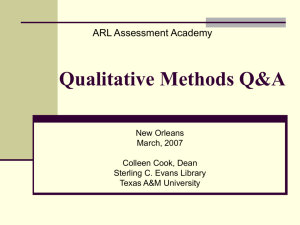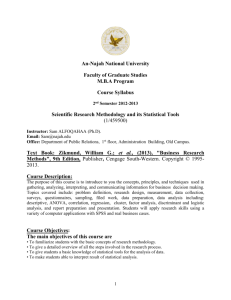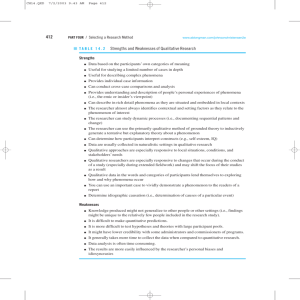
*Full Title of the Paper
Your Full Name (as it appears on your transcript)
Trinity Washington University
I have adhered to the university policy regarding academic honesty in completing
this assignment
Submitted to ** Title and Name Instructor on behalf of the faculty of the School
of Business and Graduate Studies in partial fulfillment of the degree requirements
for the Full Name of the ***Degree Program
Semester Year
QUALITATIVE RESEARCH PAPER
2
Abstract
The abstract consists of 150 to 250 words in a single paragraph, see APA 6th Publication Manual
section 2.04 for guidelines regarding items to be included. After the abstract one the same page
and starting a new paragraph are keywords, in italics, that will assist others in researching
scholarly work related to your topic. Remember there is no indent in this paragraph. Your
instructor may determine the length of the abstract as long as it fits the parameters of no more
than 250 words. The abstract should be comprised of the following sentences:
One to two sentence(s) covering the general context of the research topic
One to two sentence(s) covering the specific context of the research topic
One to two sentence(s) regarding the research problem
One sentence regarding the research methodology (data collection strategy)
One sentence regarding the data analysis strategy
One to two sentences regarding the significant findings (conclusions,
recommendations, implications)
Keywords: Include topic, major theories and theorists, keywords others might use to find
your work, research methods, and data analysis strategy.
*Note that the shortened title header and page number begin here on the second page with page #
2. When you set up your shortened title as the header, do that on the title page, then select different first
page in the header design tab. Also, there should be no lists in an abstract. It is one solid paragraph, two
if necessary. *Acknowledgements or Dedications would each have their own page following the abstract
and before the Table of Contents. *All front matter has regular, not bold, headings and none of the front
matter appears in the table of contents.
QUALITATIVE RESEARCH PAPER
3
Table of Contents
Page
Introduction ..................................................................................................................................... 6
Statement of the Problem .................................................................................................... 6
Purpose of the Study ........................................................................................................... 6
Significance of the Study .................................................................................................... 6
Theoretical Perspective ....................................................................................................... 6
Research Method ................................................................................................................ 6
Assumptions and Limitations ............................................................................................. 6
Summary ............................................................................................................................. 6
Literature Review............................................................................................................................ 7
Sections – there should be several ...................................................................................... 7
*Subject of Case Study ......................................................Error! Bookmark not defined.
Review of Related Research ..............................................Error! Bookmark not defined.
Theoretical Construct .......................................................................................................... 7
Summary ............................................................................................................................. 7
Research Methods ........................................................................................................................... 8
Research Questions ............................................................................................................. 8
Setting ................................................................................................................................. 8
Population ........................................................................................................................... 8
*Data Source(s) ................................................................................................................... 8
Ethical Considerations ........................................................................................................ 8
Research Design.................................................................................................................. 8
*Intervention Protocol ........................................................................................................ 8
Interview Instrument and Protocol...................................................................................... 9
Data Analysis Strategy........................................................................................................ 9
Summary ............................................................................................................................. 9
Findings......................................................................................................................................... 10
Participants ........................................................................................................................ 10
Data Analysis and Coding ................................................................................................ 10
Summary ........................................................................................................................... 10
QUALITATIVE RESEARCH PAPER
4
Discussion ..................................................................................................................................... 11
Research Questions ........................................................................................................... 11
Conclusions ....................................................................................................................... 11
Recommendations and Implications ................................................................................. 11
Summary ........................................................................................................................... 11
References ..................................................................................................................................... 12
Appendices .................................................................................................................................... 14
Appendix A: Recruitment Materials: English................................................................... 14
Appendix B: Recruitment Materials: Español ...................Error! Bookmark not defined.
Appendix C: Informed Consent Form .............................................................................. 16
Appendix D: Interview Instrument ................................................................................... 16
*Use Heading One, primary level heading, for each chapter, and Heading Two for each
secondary level heading (indented 0.5”) for each section within the chapter. Third level and below
headings do not appear in the Table of Contents. The Table of Contents ends with the Appendices section.
Use the MS Word heading function to establish your two heading levels and to edit how they appear in
the document. Then you can use the Table of Contents builder to auto-create the table of Contents.
Microsoft Help in MS Word can assist you with learning this.
QUALITATIVE RESEARCH PAPER
5
List of Tables
Page
Table 1. The coding key for transformative learning .................... Error! Bookmark not defined.
Table 2. Meta-codes: The three aspects of Latina women’s cultureError! Bookmark not defined.
List of Figures
Page
Figure 1. Qualitative theoretical construct as a literature map ...... Error! Bookmark not defined.
Figure 2. Qualitative theoretical construct as a process ................. Error! Bookmark not defined.
Figure 3. Qualitative theoretical construct as a cycle ......................................................................7
Figure 4. Coding chart for conflict emotion charts ........................ Error! Bookmark not defined.
Figure 5. Qualifying interview participants ................................... Error! Bookmark not defined.
*Note: you may place the list of tables and the list of figures on one page, but you should choose
to put them on separate pages if either list is extensive.
QUALITATIVE RESEARCH PAPER
6
Introduction
The literature review begins with a Preamble, which is not indicated with a heading.
Statement of the Problem
Purpose of the Study
Significance of the Study
Theoretical Perspective
Research Method
Assumptions and Limitations
Summary
QUALITATIVE RESEARCH PAPER
7
Literature Review
The introduction is both an expansion of your abstract and a more concise summation of
the argument in the preamble of the introduction.
Sections
Theoretical Construct
Factor one.
Factor 2. and etcetera.
Academic
rigor
Vague
direction
Complex
assignment
Physical
Stress
Psychological
Sress
Figure 1. Theoretical construct of the precedents for plagiarism.
Summary
QUALITATIVE RESEARCH PAPER
8
Research Methods
Begin the chapter with a preamble (a discussion of what will be covered or accomplished
in this chapter and is presented without a subsection heading).
Research Questions
Research question one (RQ1):
Research question two (RQ2):
Research question three (RQ3):
Population
Setting
Ethical Considerations
Research Design
*Intervention Protocol
QUALITATIVE RESEARCH PAPER
Interview Instrument and Protocol
Data Analysis Strategy
Summary
9
QUALITATIVE RESEARCH PAPER
10
Findings
As in the previous chapters the findings begins with a preamble, a paragraph describing
what will be covered or accomplished in this chapter.
Participants
Data Analysis and Coding
Qualitative methodologies should include three levels of coding to ensure the rigor of
your analysis.
Primary level coding for naming from concepts to categories and then to themes.
Secondary level coding to analyze the relationships between the themes resulting
from the primary level coding.
Triangulation of the resulting combined upper level understanding, based on the primary
and secondary coding, which is compared to the raw data to establish fit and appropriateness.
Summary
QUALITATIVE RESEARCH PAPER
11
Discussion
As in the previous chapters the discussion begins with a preamble, a paragraph describing
what will be covered or accomplished in this chapter.
Research Questions
RQ 1: restate the research question.
RQ 2: and so on
Conclusions
Recommendations
Implications.
Summary
QUALITATIVE RESEARCH PAPER
12
References
The references section is written in the hanging indent style and with a sentence space of 1.5 for
improved readability. There must be a reference for every work cited, and nothing
should be referenced that is not cited, in the entire document.
See the APA 6th Publication Manual, chapter 7 for the appropriate reference styles for each type
of source used.
Your reference section should include every work cited in the paper. The reference section of an
APA research paper is unlike a bibliography from other publishing styles. The reference
section of this paper may only include works that you have cited in the document. You
may not include items that influenced you, or are recommended reading, only include
what you have actually cited.
For example,
American Psychological Association, (2009). Publication manual of the American psychological
association 6th Edition, Washington, D.C.: Author
Booth, W. C, Colomb, G.G., & Williams, J. L. (2008). The craft of research, (3rd ed.), Chicago,
IL, Chicago University Press.
*Use Chapters 3 to 5 to clarify your topic into questions.
Creswell, J. S. (2014). Research design: Qualitative, quantitative, and mixed methods
approaches. (4th ed.), Thousand Oaks, CA: Sage Publishing
Krippendorff, K. (2006). Reliability in content analysis: Some common misconceptions and
recommendations. Human Communication Research 30(3) 411–433
Krippendorff, K. (2013). Content analysis: An introduction to its methodology. Thousand Oaks,
CA: Sage Publications
Lester, J. D. & Lester, J. D. Jr. (2011). Writing research papers: A complete guide, Upper Saddle
River, NJ: Pearson Longman.
*Use chapter 7, sections F & G to develop an annotated bibliography and turn it into a
literature review.
QUALITATIVE RESEARCH PAPER
Merriam, S. B. (2009). Qualitative research: a guide to design and implementation. Thousand
Oaks, CA: Sage Publishing.
*Use all chapters as they are helpful.
Merriam, S. B. & Tisdell, E. J. (2016). Qualitative research: a guide to design and
implementation. Thousand Oaks, CA: Sage Publishing.
*Use all chapters as they are helpful.
Paul, R. & Elder, L. (2008). The miniature guide to critical thinking: Concepts and tools.
Dillon Beach, CA: Foundation for Critical Thinking.
Remler, D. K. & Van Ryzin, G. G. (2010). Research methods in practice: Strategies for
description and causation. Thousand Oaks, CA: Sage Publishing.
Saldana, J. (2009). The coding manual for qualitative researchers. Thousand Oaks, CA: Sage
Publishing.
*The appropriate sections for your primary and secondary coding of the data.
Schensul, S. L., Schensul, J. J., & LeCompte, M. D. (1999) Essential ethnographic methods:
Observations, interviews, and questionnaires. In Ethnographer’s Toolkit Schensul, J. J.,
& LeCompte, M. D. (Eds.) Lanham, MD: Altamira Press
Schensul, J. J., & LeCompte, M. D. (2013) Essential ethnographic methods: Observations,
interviews, and questionnaires. In Ethnographer’s Toolkit Schensul, J. J., & LeCompte,
M. D. (Eds.) Lanham, MD: Altamira Press
*The appropriate chapter for surveys or interviews.
Shenton, A. K. (2004). Strategies for ensuring trustworthiness in qualitative research projects.
Education for Information 22 63–75
Szafran, R. (2012). Answering questions with statistics. Thousand Oaks, CA: Sage Publishing
Yin, R. K., (2013). Case study research: Design and methods (5th ed.), Thousand Oaks, CA:
Sage Publishing. *The standard for case study research.
13
QUALITATIVE RESEARCH PAPER
14
Appendices
Appendix A: Recruitment Materials: English
October xx, 201x
Dear Parents/ Guardians:
My name is ____________________ and I am a graduate student at Trinity Washington
University. I am studying Health Administration with a focus on Public and Community Health
Management.
I am sending this letter to explain why I would like you to participate in my research
study. While many parents have a great deal of influence over how their children diet and
exercise while young; this study will provide you with health and dietary information to benefit
you and your family’s lifestyle. I am studying whether parental health education can help
increase health understanding, behaviors, attitudes and beliefs about childhood obesity. The
research study will only include parents of children in grades Pre-kindergarten and Kindergarten.
With your permission; I will ask you to complete a 25 questioned survey, next I will
provide you with daily useful health educational materials about improving your child’s health
and physical activity, to reduce childhood obesity and finally I will ask you to re-take the initial
survey for understanding. The survey would take about 20 minutes. The survey and all health
information will be provided in English and Spanish.
Your participation in this study is completely voluntary and is not associated with
Raymond Elementary School or the District of Columbia Public School System and will not
affect you or your rights in any way. You may quit this study at any time, by simply writing on
the survey “I want to stop” or “I do not wish to participate.” The study will be conducted
beginning the week of October …, 2013 through October …., 2013. The first survey will be
provided to you during the drop off / pick up times and again during the Parent Wellness
meeting.
There are minimal risks involved; this study will be used for education purposed only, as
I seek to gain better understand of parental health education and how health promotions can
QUALITATIVE RESEARCH PAPER
15
benefit schools.
To protect your confidentiality, your name will not appear on the survey, I will only use
data and results from the survey, without including your name. This survey will not be shared
with anyone other than myself, ______________ (student researcher) and my Professor Dr.
_______________, at Trinity Washington University. If you have any questions or if you would
like to receive a final copy of this research study after completion, please feel free to contact me
at (202) 884-9620.
This letter will serve as a consent form for your participation and will be kept in my
personal locked file for a minimal of three years after completion of the study. If you have any
questions about this research, please call Dr. ________________, my research supervisor for this
project or the School of Business and Graduate Studies at Trinity Washington University at (202)
884-9000.
Please return this form to Ms. Student directly by _______________.
Sincerely
MSA Candidate
Trinity Washington University
@mail address: @trinitydc.edu
QUALITATIVE RESEARCH PAPER
16
Appendix B: Informed Consent Form
Title of your Research Study
I would like to invite you to participate in a research study examining ____________________________.
My name is ________________________________ and the data collected in this interview will help
fulfill
the
requirements
for
a
Master
of
Science
in
Administration
in
_________________________________________ at Trinity Washington University. I am under the
supervision of my faculty advisor Dr. ____________________.
Participation Requires of You: To (describe what they will do, i.e. to be interviewed, to complete the
survey, etcetera) ____________________________________________________. There is no planned
use of deception involved in this study.
Your Privacy: Your participation in this study and your responses will be kept confidential. Any
reference to you will be by pseudonym, including any direct quotes from your responses. This document
and any notes or recordings that might personally identify you as a participant in this study will be kept in
a locked place that only the researcher will have access to. Only the researcher and the research
supervisor might know who has participated in this study. Three years after the completion of this
research study all personally identifying information will be destroyed.
Risks to you: There are five acknowledged risks generally associated with participation in research
studies such as this one: Physical, psychological, social, economic, and legal. The researcher foresees
minimal risk for those who choose to participate in this study. There are no foreseen physical risks
associated with this study; other risks might include the following:
You might experience anxiety, discomfort, or negative emotions as a result of responding to the
questions asked of them in this research study. If you experience a negative reaction, you may
choose to skip the question, to withdraw from the study, or you may contact my faculty advisor or
the BGS Institutional Review Board, especially if your discomfort continues after the study. See
the contact information on the page below.
You might experience social, economic, or legal implications if you share your responses or your
participation in this study with others. If you choose to participate in this study, you are
encouraged to keep your participation in this study and your responses confidential. The
researcher will maintain your confidentiality throughout the study, and will destroy the records of
your participation three years after the study is complete.
Benefits to You: There are not foreseen direct benefits to you regarding participation in this study beyond
the general knowledge that you are assisting in furthering the knowledge related to this research topic,
and assisting the researcher in completing the MSA degree requirements. There is no compensation
associated with participation in this study.
QUALITATIVE RESEARCH PAPER
17
Informed Consent Form, page 2
Title of your Research Study
This document acknowledges I understand of my rights as a participant in this study, which the
researcher has explained to me prior to signing this document.
I acknowledge that the researcher has explained my rights, the requirements of this study, and
the potential risks involved in participating in this study. I understand there is no compensation
for, or direct benefit of participating in this study. By signing below and providing my contact
information I am indicating that I consent to participate in this study, that I am at least 18 years
of age, and I am eligible to participate in this study.
I may withdraw from this study at any time by notifying the researcher by email. If I have any
concerns regarding my participation in this research study I may contact the research supervisor,
Dr. ______________________, or the BGS Institutional Review Board (IRB), which oversees
the ethical practice of student research at the Trinity Washington University School of Business
and Graduate Studies. I may ask for a copy of this document for my own records.
Signed Name: _____________________________________________ Date: _______________
Printed Name: _____________________________________
Phone Number, Email Address, or Postal Address: ____________________________________
_____________________________________________________________________________
Thank you for your participation,
Student’s name
MSA in ___________________
Trinity Washington University
Email Address: @students.trinitydc.edu
Dr. ________________________
MSA Candidate
Trinity Washington University
@mail address: @trinitydc.edu
(202) 884-9640
BGS Institutional Review Board Committee
(202) 884-9640, or
Email BGS@trinintydc.edu with BGS IRB in the subject line.
QUALITATIVE RESEARCH PAPER
18
Appendix C: Interview Instrument
Insert an MS Word friendly version of your interview here in this appendix. This should
be all the questions included and the text should be exact as it was reviewed and approved by the
IRB committee.
*Note that if you copy directly from Google Forms or Survey Monkey you will bring many
macros and other security issues with the text and then you will cause security issues in working with
your document for the Trinity BGS Faculty. This survey needs only the text and images necessary for the
faculty and the IRB committee to review, it does not need to be exact in format and font.
Interview Example:
Open-ended Questions
How do you define your culture or cultural background?
Given the definition of authentic leadership presented to you, can you describe how you
express yourself as an authentic leader?
How would you define who you are in the sense of your leadership identity?
Can you tell me more about your experience as a Latina woman leader?
Semi-directed Questions
Self-awareness
How do you think your culture has influenced your strengths and weaknesses as a leader?
In what ways does your cultural background shape your emotions, motives, and goals?
What role does your cultural background play in your acceptance of your leadership
identity, who you are at the deepest level?
Moral Perspective
How does your culture influence your professional decision-making (versus external
influences, such as societal pressure, popular trends, etc)?
How does your culture inform your values and morals?
Balanced Processing
How do you feel your culture has influenced you to seek out or overlook others' opinions
in your decision making?
In what ways does your cultural background make you more or less open to other’s
perspectives?
Relational Transparency
QUALITATIVE RESEARCH PAPER
19
How does your culture influence your professional relationships with others? (Are
you more/less open, honest, outgoing, private, etc?)
How does your culture influence how you communicate with others
Henderson, Z. M. (2012). Latina Authentic Leadership: The Implications of Culture on Authentic
Leadership among Latina Women Leaders. Trinity Washington University, Washington DC.








